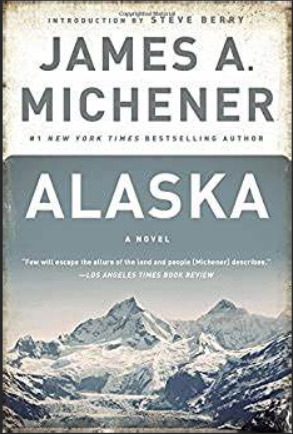Posted: July 24, 2022
Alaska
James A. Michener
Alaska is shown as a place that - refreshingly - man can never fully dominate. Elemental nature will always be the master in this rugged land.
Alaska covers a period from the formation of Alaska as a landmass to the mid-80s.
Michener starts us off with description of the geologic history of Alaska, justifing why he calls it an "icebox", essentially a flatland of steppe, tundra and swamp hemmed in by impassable mountains north and south.
During these times, there was a landbridge linking Alaska to Siberia and Michener describes the migration of key animals such as the mastodon and the mammoth.
Next Michener discribes the migration of people, starting with the Athapascans, one of whose offshoots is the Tlingit tribe. Then we follow the Eskimo migration and Michener shows us the sea-based lifestyle of these people; we accompany them during their hunt for seals and whales. Lastly we are introduced to the Aleuts another tribe who will occupy the Alaskan island chain named after them.
It is the 1700s now as the Russians discover and colonize Alaska. A lot of unregulated hunting here as well as the enslavery of the Aleuts. The Russion portion if this novel is easily the most brutal and savage. The Russians establish their base at Sitka.
The Russians would eventually sell Alaska to the Americans who would initially refuse to govern it properly, resulting in a very wild, lawless frontier. Here Michener takes us on adventures with Michael Healy, a legendary ship captain. We are witness to Healy's rivalry with a rogue captain called Emis Schransky. We also accompany a Prebyterian missionary, Sheldon Jackson, who ranged far and wide in Alaska establishing churches.
The novel then turns the story to the gold rush in both the Klondike and Nome, in the latter place gold deposits can be found by panning the beaches. We accompany the hopeful gold seekers on the stupendously difficult journey to the gold fields and we are given a taste of how mining was done in those lawless territories.
As the story progresses, American business, in the form of a Seattle firm called Ross & Raglan, begin to exploit Alaska for its salmon as well as monopolize all of incoming trade. At the same time Ross & Raglan does everything in its power to keep Alaska from becoming a state of the Union.
Eventually though, Alaska does win its place as the 49th state and we are given the details of how the United States government has set about protecting Native Alaskan rights during this period with gifts of land to natives and the formation of native corporations.
The book ends with some stories about how people from other states wind up in Alaska, of the plans other countries have for Alaska, and a look at the place of Alaska as the most active part of the Pacific Rim of Fire.
I read and enjoyed a lot of Michener during my teens and late twenties but I barely remember them. I do have a favorable impression of his books so I decided to take him up again. I have not read all of his extensive bibliography but I have read a good selection - one of them is "Alaska". I wanted to read a Michener book that I had read already in the hopes of waking up some nascent memories.
One thing I'm happy to report is that I was right about my memories of Michener books being good. He's a smooth writer with a flowing style. Thankfully so because "Alaska", like most of his other books, is a doorstopper at more than a thousand pages.
When the word "Alaska" is mentioned I automatically think of Eskimos. It turns out that there several other tribes like the Athapascans, Aleuts, and Tlingits. The Eskimos themselves are composed of two distinct sub tribes.
The early part of this book dealing with prehistoric times and telling stories about the mastodon, mammoths, and early man in Alaska was a time-travelling treat for me.
I dreaded this re-reading because one of the things I remember was a horrible section depicting the gang rape of an innocent Alaskan native girl. I now know that this girl was Cidaq, the Aleut. But her story, instead of upsetting me as it did before, is now something that inspires me. Cidaq shows me that terrible things can happen but one can face them with fortitude.
The Russian behavior in Alaska as depicted in this book is appalling. So appalling that I'm prepared to hold off on judgement here seeing that this book was written by an American during the time of the Cold War.
The gold mining part gives a wonderful description of gold and how the mining of gold was done in those days. The salmon section takes us through the lifecycle of the salmon and the workings of a salmon cannery.
All throughout the book Michener describes the breathtaking scenery and landscape of Alaska - the cold, and the beauty and the vastness - and the danger.
After reading this book I am most appreciative of the information I was given about Alaska, its land, peoples, and history. And to be given it in the form of a pleasurable and, at times, an exciting read.
I'm shocked at how relatively unknown Michener is these days, but I read him when he dominated the bestseller lists. He doesn't deserve to become obscure. "Alaska" for one, is a profitable and pleasurable read. You will learn and be enriched by the knowledge.